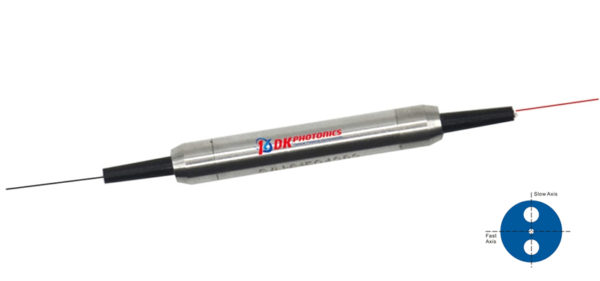The in-line polarizer is a micro-optic device typically used to convert unpolarized light into polarized one including high extinction ration in the case. It is effectively used to enhance the signal’s extinction ration. A good quality in-line polarizer offers a high extinction ratio, high return loss, low insertion loss, and absolute environmental reliability and stability. It is ideally used in high-speed communication systems and applications like test instrumentation.

There’re two most common types of the in-line polarizer – Pigtail and No-tail.
Pigtail vs. No-tail:
In the pigtail version of the in-line polarizer, input/output fibers are attached to the package, whereas no-tail version often comes with two fiber connectors mounted straight on the package. No-tail version is best for applications where there’s no need for extra fiber length and a number of fiber jumpers/connections are already in the system.
The pigtailed polarizers are best used for fiber systems requiring optical components spliced to the networks or extra fiber is required to fill the gap between the lengths. This version of polarizer provides a great level of flexibility in device mounting and installation. The typical pigtail length is 1 to 2 meters on each side. The diameter of fiber buffer or jacket can be specified by an individual while discussing the requirements with an in-line polarizer manufacturer.
Pigtail fiber type
The pigtailed in-line polarizers have input/output fiber in three types of combinations:
- SM/SM – Single mode to single mode
- SM/PM – Single mode to polarization maintaining fiber
- PM/PM – Polarization maintaining to polarization maintaining fiber
SM/SM fiber pigtailed polarizer works bi-directionally. The input and output ports are exchangeable except if the client determines a special combination of connectors.
SM/PM fiber pigtailed polarizer has the transmission hub of the polarizer adjusted to the slow axes of the polarization maintaining fiber. The output PM fiber is additionally keyed to the slow axes at the connector. Both the fibers are typically marked as ‘SM’ and ‘PM’ before shipment.
PM/PM fiber pigtailed in-line polarizer has (similar to SM/PM) polarizer transmission hub adjusted to the slow axes of both PM fibers. In spite of the fact that the PM/PM in-line polarizer is also bi-directional, it is often advised that client connects the device as indicated by the predetermined input and out directions in order to achieve the best extinction ration. They are also marked before shipment.
Fiber connectors
As per a client’s specification’s fiber connectors can either be SC/PC, FC/PC or FC/APC. Fiber connectors should always be cleaned with the help of fiber connector cleaning techniques followed as per the industry standard.
Following are some in-line polarizer applications
- Fiber Amplifiers
- Fiber lasers
- Fiber Sensor
- Test and Measurement
- Communications System
Some of the top features which are common with every polarizer
- Low Insertion Loss
- High Power Handling
- High Extinction Ratio
- Low Cost
- High Reliability
You can also add one or more features according to your requirements. In addition, it is advised to choose a trusted supplier who has been providing quality polarizers and other fiber optic products for a long time in your country.